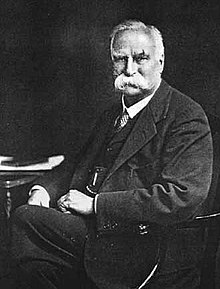E. B. Poulton
| Sir Edward Bagnall Poulton | |
|---|---|

Sir Edward Bagnall Poulton
Photograph by James Lafayette |
|
| Born | 27 January 1856 |
| Died | 20 November 1943 (aged 87) |
| Nationality | English |
| Alma mater | Jesus College, Oxford |
| Known for | Aposematism, frequency-dependent selection, camouflage |
| Awards |
Linnean Medal (1922) Hope Professor of Zoology |
| Scientific career | |
| Fields | Evolutionary biology |
| Institutions | University of Oxford |
| Influences | Charles Darwin, August Weismann, Alfred Russel Wallace |
Sir Edward Bagnall Poulton, FRSHFRSE (27 January 1856 – 20 November 1943) was a British evolutionary biologist who was a lifelong advocate of natural selection through a period in which many scientists such as Reginald Punnett doubted its importance. He invented the term sympatric for evolution of species in the same place, and in his book The Colours of Animals (1890) was the first to recognise frequency-dependent selection.
Poulton is also remembered for his pioneering work on animal coloration. He is credited with inventing the term aposematism for warning coloration, as well as for his experiments on 'protective coloration' (camouflage).
Poulton became Hope Professor of Zoology at the University of Oxford in 1893.
He was born in Reading, Berkshire on 27 January 1856 the son of the architect, William Ford Poulton and his wife, Georgina Sabrina Bagnall. He was educated at Oakley House School in Reading.
Between 1873 and 1876, Poulton studied at Jesus College, Oxford under George Rolleston and the anti-Darwinian entomologist John Obadiah Westwood, graduating with a first-class degree in natural science. He maintained an unbroken connection with the college for seventy years as scholar, lecturer and Fellow (appointed to a fellowship in 1898) until his death.
He was knighted by King George V in 1935.
...
Wikipedia
